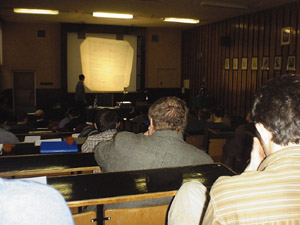A recent meeting in Cracow gave an overview of developments in B physics.

The mysterious phenomenon of CP violation – which ultimately distinguishes matter from antimatter – has kept physicists busy since its experimental discovery in kaon decays some 35 years ago.
In CP (charge/parity) symmetry, the physics of left-handed particles is the same as that of right-handed antiparticles. CP symmetry became popular after physicists were shocked to discover in 1956 that nuclear beta decay, a fundamental weak interaction, is spectacularly left-right asymmetric (P-violating). The confusion grew in 1964 when new experiments found that the CP criterion was not 100% reliable either. Ever since then, physicists have sought to understand how and why this symmetry is flawed.
Today the effects of CP violation are expected to manifest themselves in the decays of B mesons (containing the fifth or “b” quark) as well as in the traditional kaons. This change prompted Cracow physicists from the Institute of Nuclear Physics, the Jagellonian University, and the Faculty of Physics and Nuclear Techniques of the University of Mining and Metallurgy – co-organizers of the annual Cracow Epiphany Conference – to choose B physics and CP violation as the topic of this year’s meeting, which was held in Cracow in January.
The past two years have brought a real breakthrough in experimental observations. Participants at the conference heard Bertrand Vallage and Taku Yamanaka describe the latest news from NA48 and KTeV on measuring direct CP violation in neutral kaon decays. The long-awaited measurements of CP violation in B decays by the Belle and BaBar experiments operating at the KEKB and PEP-II B-factories, and from the CDF detector at Fermilab’s Tevatron proton-antiproton collider, were presented by Kenkichi Miabayashi, Vasilii Shelkov and Slawek Tkaczyk.
In addition to new results on rare B decays presented in the talks on BaBar and Belle, many interesting B measurements from CLEO were shown by Karl Berkelman – CLEO has been studying B physics for more than 20 years. For ongoing experiments, Wouter Hulsbergen from HERA-B at DESY, Andreas Schopper from LHCb and Maria Smizanska from ATLAS at LHC presented the prospects in the B sector.
Among many activities in the field of kaon decays, the ambitious KAMI project at Fermilab to measure direct CP violation in ultra-rare long-lived neutral kaon decays was presented by Taku Yamanaka. Furthermore, as discussed by Fabrizio Scuri, new precision results in the kaon sector can be expected soon from the KLOE experiment at DAPHNE. Together with the data collected by the CPLEAR and LEP experiments (reviewed by Andreas Schopper, Tadeusz Lesiak and Celso Martinez-Rivero), it is clear that there will be plenty of new experimental information on B physics and CP violation.
Challenging the Standard Model
Understanding all of this experimental data will present a challenge for the theory. With the most popular theoretical description of CP violation also being the one provided by the conventional Standard Model (SM), different ways of testing this picture were presented.
For B meson decays, the extraction of parameters from the data was discussed in some detail by Ahmed Ali. The topic of radiative B decays and radiative transitions of b to strange quarks was reviewed by Mikolaj Misiak. With the b-quark mass being fairly large, theoretical approaches for infinite b mass were presented by Chris Sachrajda, Bennie Ward and Thomas Mannel, while Andre Hoang discussed the issue of b mass and non-relativistic effective quark theory. Jose Bernabeu showed how B decays can probe not only CP- but also T- and CPT-violating effects.
A few theoretical talks looked at CP problems in physics beyond the SM. These included effects in supersymmetry (Leszek Roszkowski) and Higgs boson interactions (Bohdan Grzadkowski). Peter Minkowski gave a talk on the perpetually intriguing subject of neutrinos. The conference was summarized by Roy Aleksan.
The Cracow Epiphany Conference has had a different topic every year since 1995, when the series was initiated by Marek Jezabek, chairman of the conference organizing committee. By bringing in new subjects and inviting new participants every year, each meeting can offer a general forum to discuss the frontiers of physics, while providing the Polish physics community with the opportunity to broaden its horizons and meet internationally acclaimed experts.
The next Epiphany meeting, to be held on 4-6 January 2002, will concentrate on quarks and gluons in extreme conditions.







